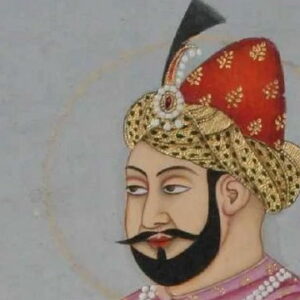Humayun was the second Mughal king of the Indian subcontinent, ruling over areas that today include Afghanistan, Pakistan, and parts of northern India. He was the son and successor of Babur, the Mughal dynasty’s founder. At the age of 23, he has crowned Mughal Emperor. At the time of his accession to the throne, he was inexperienced and faced severe rivalry from his half-brother Kamran Mirza, who ruled over Kabul and Lahore. Despite the fact that Humayun was a courageous and daring emperor, he lost various regions to his adversaries throughout the years. He, on the other hand, was not one to take defeat easily, and after a few years, he was able to reclaim his domains. He spent much of his reign defending provinces from his enemies, and he was even compelled to seek asylum in Persia for a period. After the death of his competitors, he returned to his realm as the uncontested Mughal ruler and set about strengthening the empire for future generations. He launched multiple expeditions to extend Mughal territory, and the Mughal Empire stretched nearly one million square kilometers at the time of his death. Despite not being one of the best Mughal kings, Humayun made sure that his son Akbar was left a rich legacy.
Childhood and Adolescence
Babur, the founder of the Mughal empire, and his wife Maham Begum gave birth to Humayun on March 17, 1508, in Kabul, Mughal Empire (modern-day Afghanistan). He had multiple brothers and half-brothers, many of whom would become his deadly enemies in the future.
He had a conventional upbringing for a royal of his status. He was interested in mathematics, philosophy, and astrology and mastered Turki, Arabic, and Persian. He also underwent military training and, at the age of 20, was appointed governor of Badakhshan.
As a young governor, he demonstrated his gallantry by fighting at Panipat and Khanwa, two pivotal battles in Indian history. His father instilled in him the skills of an administrator and a warrior.
Reign & Accession
On December 26, 1530, Babur died and Humayun, the Mughal dynasty’s second emperor, rose to the throne. He had to contend with his brothers’ intense rivalry, as well as threats from other kings such as Sultan Bahadur and Sher Shah Suri (Sher Khan). Kamran, his half-brother, snatched Punjab and the Indus Valley.
Both of his major opponents expanded their holdings throughout the early years of his reign. Sultan Bahadur intended to assault Humayun’s lands, but Humayun moved fast and took the forts of Mandu and Champaner, compelling Bahadur to seek asylum with the Portuguese. In 1537, Bahadur passed away.
Sher Shah Suri, meanwhile, was cementing his influence in Bihar and Bengal and establishing himself as a great monarch. He challenged the Mughal rule, and while Humayun was able to temporarily drive Sher Shah out of Bengal, he was unable to hold off Sher Shah for long.
In the deadly battle of Chausa in 1539, Sher Shah defeated the Mughals and killed nearly 8,000 Mughal men. Humayun’s strength was greatly weakened as a result of this, and to make matters worse, his own brothers were plotting against him. Sher Shah Suri continued his assault on the Mughals, driving Humayun west.
In 1540, the Mughals confronted Sher Shah’s increasing force at the Battle of Kanauj, where they were destroyed once more. The Mughals suffered more defeats, and Emperor Humayun was forced to flee the battlefield. Sher Shah also conquered Agra, the Mughals’ capital, and forced Humayun to escape India.
Humayun, his wife, and a few colleagues fled to Persia. Shah Tahmasp not only provided him with shelter but also treated him as a royal visitor. Humayun claimed Kandahar and Kabul with the help of Shah Tahmasp’s soldiers.
Meanwhile, Sher Shah Suri died in 1545, and his son and successor, Sher Shah Suri II, died in 1554, only a few years after his father. The political instability that ensued presented Humayun with the ideal chance to recover his dominion. He amassed a big army and placed it under the command of Bairam Khan, a brilliant military strategist.
The army was led by Bairam Khan, who successfully established the Mughals’ claim to the throne. On July 23, 1555, Humayun claimed Babur’s throne once more.
He embarked on a series of military expeditions to extend his dominion over areas in eastern and western India after reclaiming the Mughal throne. The Mughal Empire covered about one million square kilometers at the time of his death.
Battles of Importance
Humayun was not well-known for his military prowess. However, he recognized his limitations and, in an attempt to retake the throne of Delhi from the successors of Sher Shah Suri, he placed his army under the command of Bairam Khan. Bairam Khan was successful in recapturing the capital for Humayun, proving that this was a prudent decision.
Personal History and Legacy
Hamida Banu Begum, Mah Chuchak Begum, Bibi Gunwar Begum, Khanish Aghacha, Shaham Aghacha, and Maywa Jan Aghacha were some of Humayun’s wives and concubines. He had a number of children, including Akbar, who would go on to become one of the most famous Mughal rulers.
When the muezzin declared the Azaan, he was descending the stairwell from his library, arms full of books (the call to prayer). Hearing the summons, the emperor attempted to kneel in homage but tripped and fell down the stairs.
As a result of his injuries, he died three days later on January 27, 1556. His son Akbar took over as his successor.
Humayun was known among the Mughals for his calm demeanor and forbearance, earning him the moniker of “Inn-i-Kamil (Perfect Man).”
Estimated Net Worth
Humayun Saeed is one of the wealthiest and most well-known TV actors. Humayun Saeed’s net worth is estimated to be $12 million.


